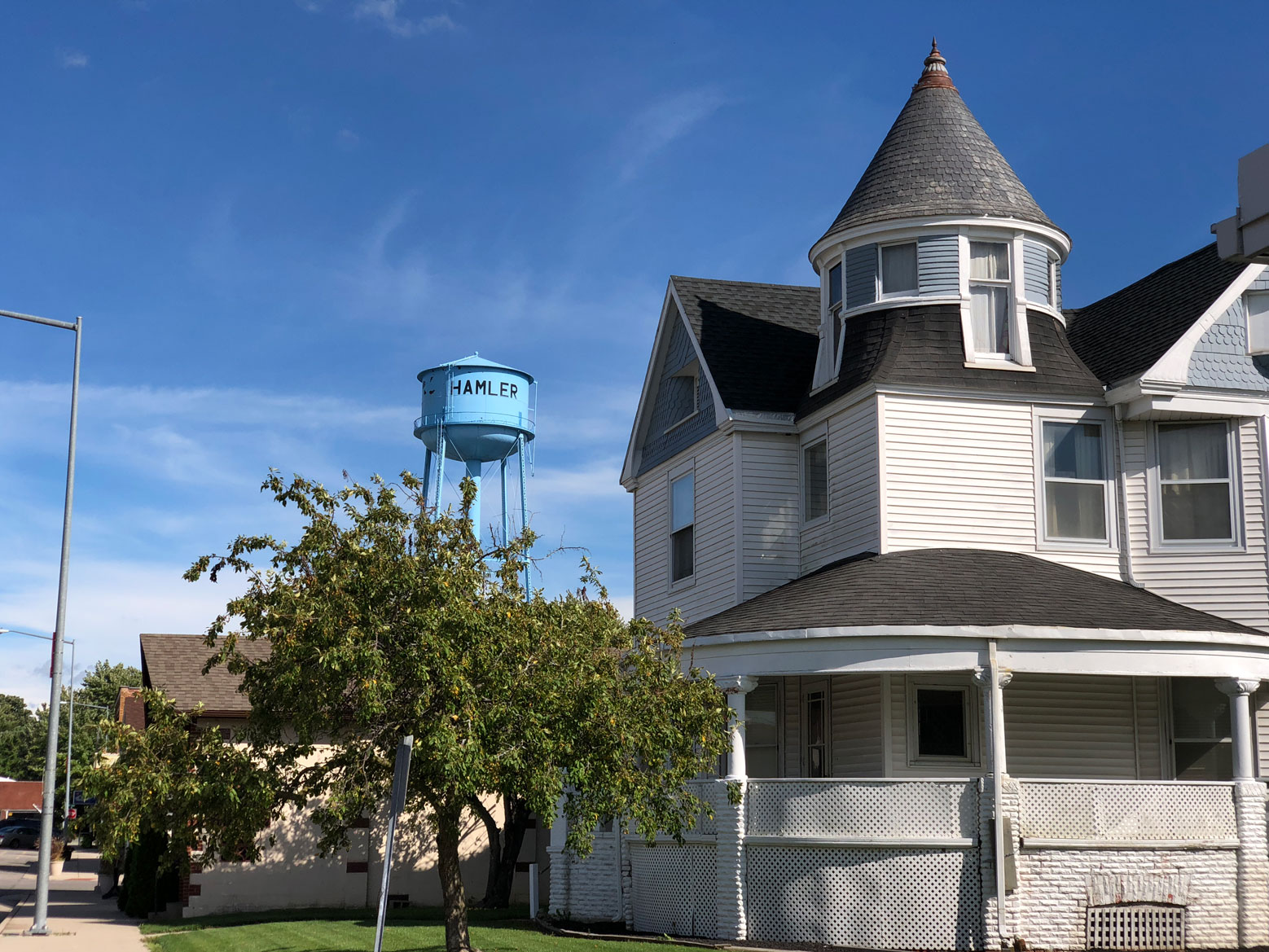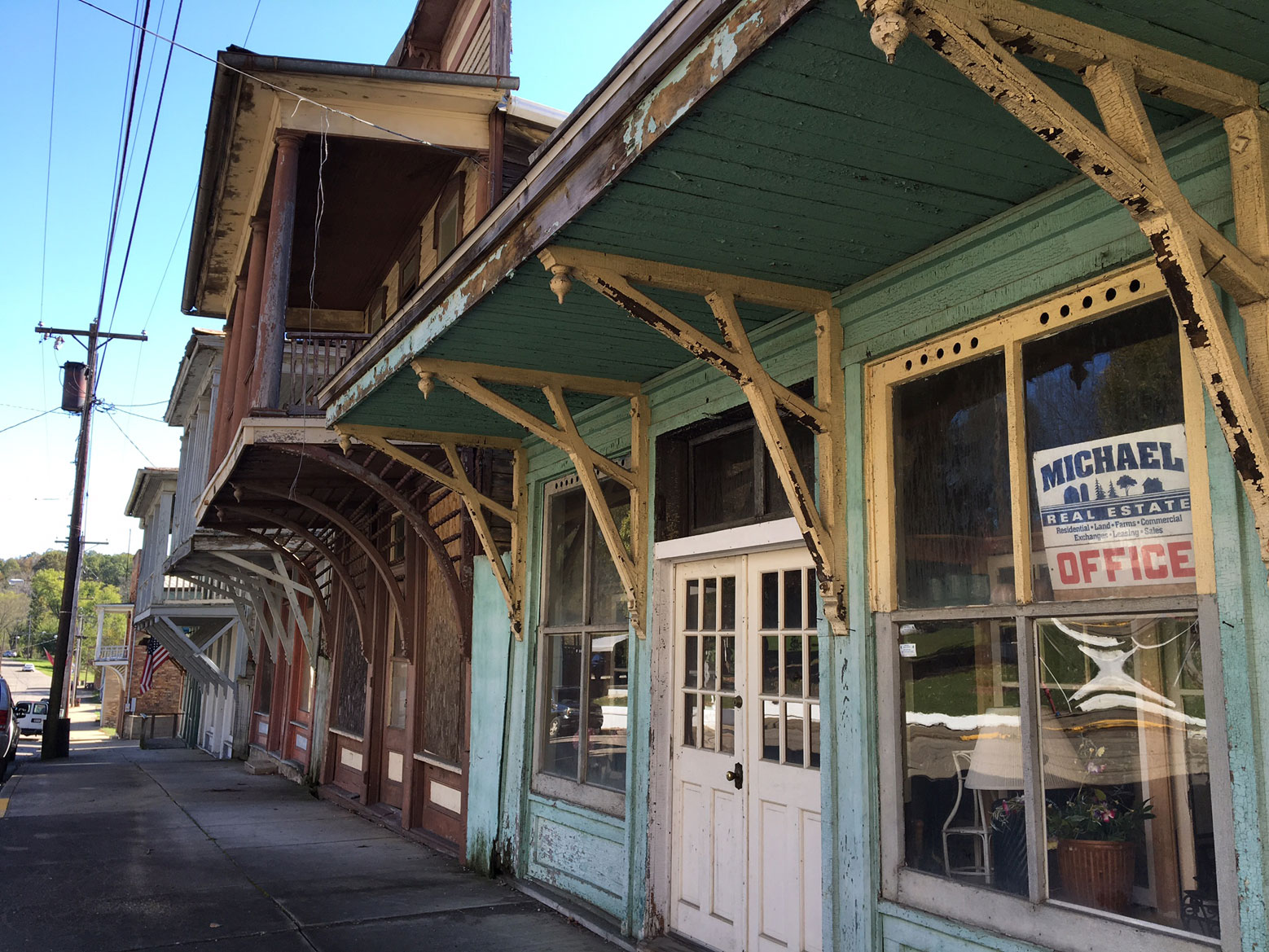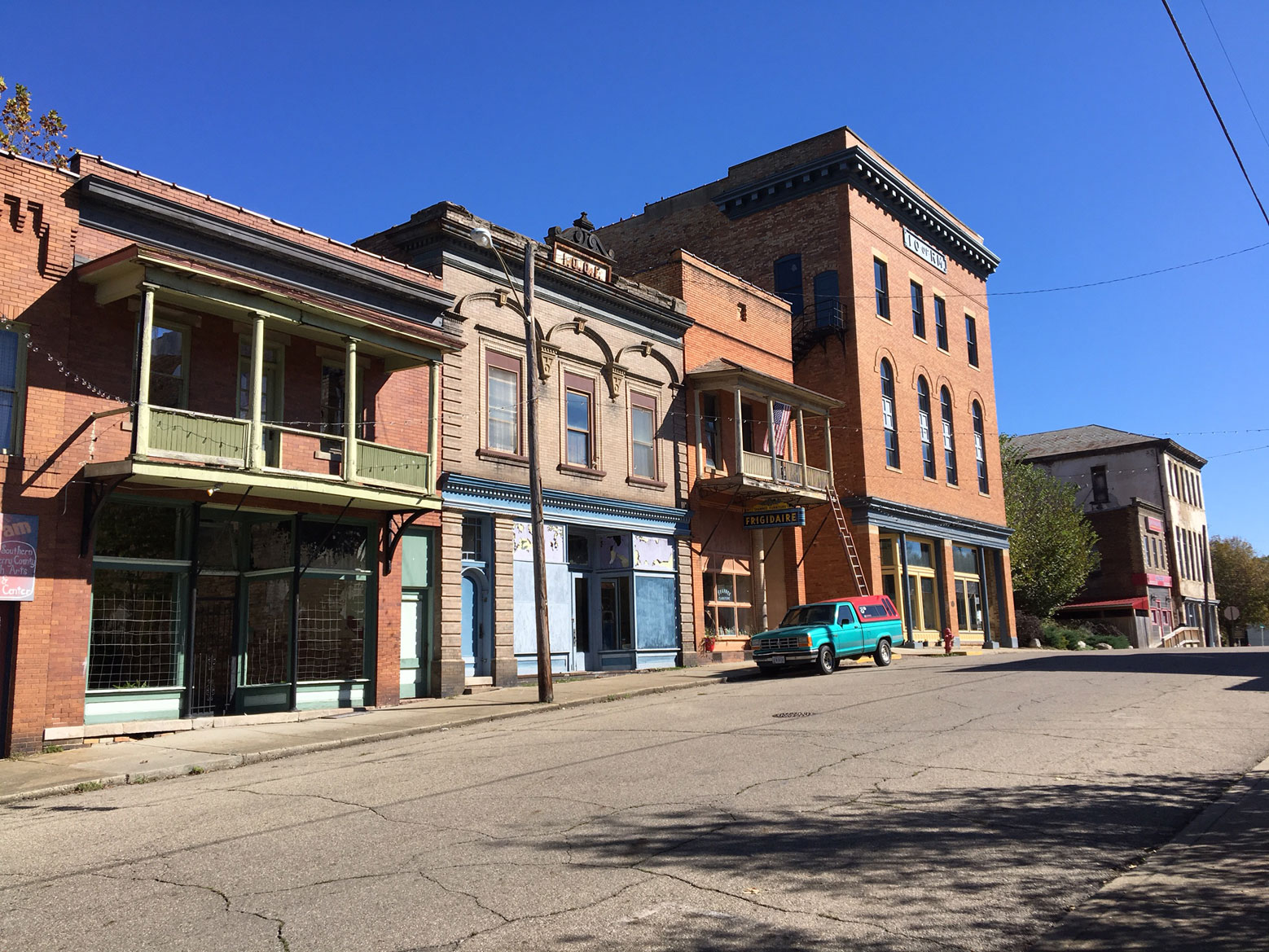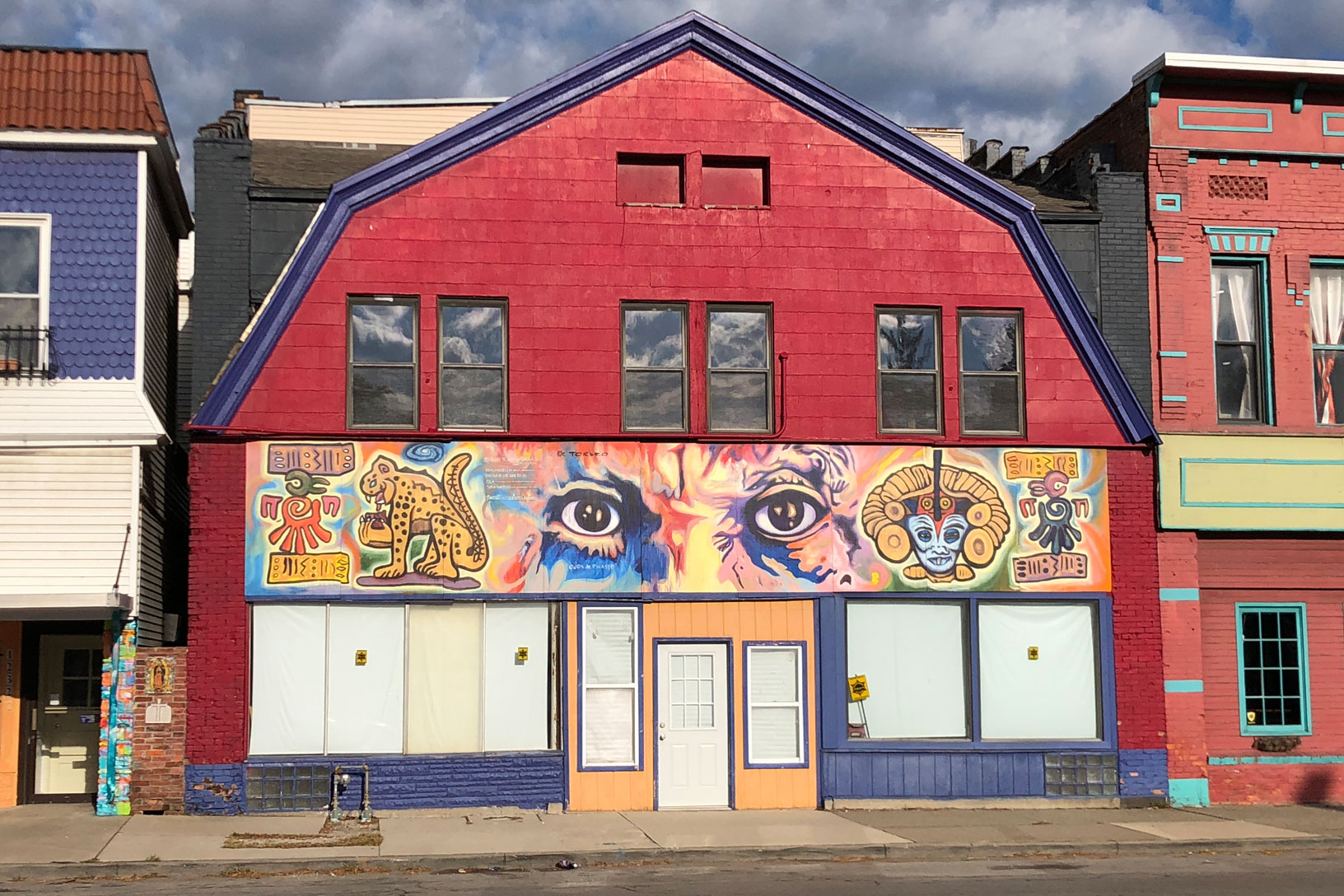In my mind, I am driving along an old highway, entering a small American town that I’ve never seen before. It is late in the day, and the sun is low. I am nearing the center of town. I should also mention that in reality it is presently May of 2020, and such a trip is forbidden to me, confined as I am to my apartment while the Coronavirus severely restrains movement and threatens street life everywhere.
But in my rich imagination, I am on the road again, doing what I have done for many years, following my intuition, my research, some playful map-reading, and perhaps a road tip from a friend. I am exploring small town Main Streets with my camera and my note pad. And since this particular excursion is the creation of my own thoughts, I am going to embellish it with a vintage car to convey me; the top is down, the radio plays cool jazz, and the steering wheel glides easily in my hands as I make one final turn for my approach to Main Street.
After a cursory sweep at the wheel up and down this central commercial corridor, I park and step out onto the sidewalk. The rest of my journey this evening will be on foot. The town is very quiet, which is not unusual in smaller towns at this time of day. The shops are all closed and the town hall and library are dark. The tavern, around the corner, is out of view. It’s too early for the restaurant. I make my acquaintance with the street and the buildings at my leisure. No one is around to puzzle over the camera hung on my neck or question my slow, curious pace. For a time, as the sun gets lower and bathes the street with a very flattering rosy gold, this place is mine. It is a charmed time for me. This is the “magic hour,” when photographers hasten their pace to capture the fleeting golden light as the sun begins to set and transform ordinary views into enchanted landscapes.
Arriving in a small town like this, I often find myself fantasizing, projecting myself into its history. I imagine myself growing up here, and dream a lifetime of memories at the old movie theatre. What if I had been a projectionist there while I was in high school? I see an old café across the street during my dream visit, a place where I might have hung out after school, or where I habitually met my dad for a quick cup of coffee before our workdays began. I can see a physical accretion of time on the façade of the café building. The old streamline moderne porcelain enamel panels of the storefront were covered in the late 1970s by rough wood siding. It might have seemed, while I was in my teens, like a great way to update that old place. But right now, in my dream visit in 2020, it disappoints, looks rough and neglected. I want the 1930s back. But I confess to myself that I rather like seeing layers of history.

I have seen plenty of towns over the years to help fuel my imagination for this fantasy visit today. I explore the silent shop windows, poke around the corner here and there to discover what’s on the side streets, admire the old houses with great front porches. This town of my imagination still has a hardware store, a true marvel considering that it competes with a Home Depot in the county seat nearby. And there is a handsome brick town hall at the end of Main Street, where it intersects the main highway. There is also a library and a working post office, both modest in design, but still delivering energy and information and life to the street.
I am not anxious about my photography this evening, because I know I will be here for a full day tomorrow and I will enjoy the magic hour once more. I will meet people and ask questions and make notes, and start to piece together a real sense of the town’s history and how it manages to survive today. I will meet the pharmacist who owns the drug store with his son-in-law, and I will chat with a few shop owners and listen with great interest to their dreams and disappointments. I will dig into the local archives and befriend a couple of very committed librarians. I will praise the owner of the cinema, a man in his 70s who makes no profit on movie showings, but he isn’t going into the red somehow. And the neon of marquee is at least 80 percent operational: no small miracle, considering the expense.
Had my visit to this small town been real and there was no virus shutting the world down, I would awaken the next day to a street with fleeting, sporadic moments of activity and the bright white glow of morning sun. I would order breakfast at the cafe, I would buy something at the pharmacy, I would prepare for my visit to the library. I would watch the comings and goings of cars at the hubs for idle conversation, the small cafes, bars, and restaurants. I would have a very full day studying the architecture and watching the people, finished off with a flourish as I watch the neon theatre marquee light up at dusk.

But this is Spring of 2020, and the harsh reality is that none of this will happen on a real visit. Business may be hurting everywhere, but Main Street is particularly devastated. Although the pharmacy is open, it is facing tough competition from the Walgreen’s on the highway with its drive-through window for medications and minimal exposure. The restaurants are all shuttered, and they, too, face competition from coffee drive-throughs and home brewers; so curbside sales are nil. Conversation is a luxury we cannot afford at the moment, unless it’s online. The hardware store opens for limited hours, but that’s the extent of retail at the moment. If somebody wants a book from the book shop, they must turn, instead, to the Walmart in the next town. Same story for the appliance and furniture stores. And the dress shop. Because Walmart sells food, the entire store is mysteriously seen as essential, the result of clumsy, short-sighted government rules for addressing the Coronavirus. In contrast, Main Street is largely padlocked. This entire reaction to the crisis has somehow, monumentally, favored corporations over small businesses. The movie marquee is dark at night, every night, and there’s little hope for opening up a business that barely makes it month to month. Yet it is seen by many as the beating heart of Main Street.
I have been writing about Main Street for many years. It chills me to think that I have been documenting something that might not survive this crisis, that may exist someday only in photographs. That’s not such an extreme statement when you consider how the merchants have been operating with such thin profit margins for a long time, and they may now live many months with no income at all. Restarting failed businesses may take decades. And buildings need tenants and cash flow, or they are neglected and fall eventually to rubble. Sometimes I am questioned about the relevance of Main Street. I sometimes hear, “It’s just a museum of its former self. It isn’t real, it’s a theme park.” That has not been my experience. Main Street is indeed greatly changed from what it was fifty years ago, but it has responded to its challenges with very well-reasoned strategies, like emphasizing experiences and services over everyday goods. And Main Street is still the center of town, and certainly more than a shopping center. It is the home of local government and culture, a repository of history, and a place where people live. It is where parades happen. It is the supreme American gathering place.

As we have sheltered in place for months now, it has been suggested that we have collectively realized that we can survive, if not thrive, without being in each other’s presence nearly as much as we used to be. Instead, I believe we have learned, with a vengeance, how very essential it is to be truly face to face. This real proximity allows us to focus better, to comprehend more clearly via body language and eye contact, and to spontaneously break away from group conversations to share one-on-one. Although my focus is primarily on the architecture of Main Street, what resonates most for me is what I have learned by talking to the citizens who use this street. My conversations have truly colored the way I see it, how I understand its historic evolution, how it adjusted to change, how and why its buildings are loved or abused. The conversations held at libraries every day are small but essential. So are the talks held at the cafes and taverns. And the idle chats between merchants and customers.
As much as I cherish arriving in a new town during that special quiet spell before sunset, what brings greatest pleasure for me is the next day, when people start moving about and the place hums as best it can. And at night, when I thrill to the illumination of the neon on the façade of the movie theatre, the greatest gratification actually comes from seeing people start to arrive for the movie, pausing under the marquee for a moment, one by one, buying their tickets. And when a movie showing ends, and a small surge of people step outside under that illuminated canopy to share thoughts about their experience, or plan their next step, I feel a sort of envy… or perhaps ecstasy. My heart swells, seeing not only that this great little building has been preserved, but that it continues to be used and enjoyed. I vividly realize that this place, the whole street, seems very much alive…and quietly, though resolutely, valued by its citizens. And that burn of emotion I feel when I stand there watching, yearning to join them, reminds me how important it is that this life is able to continue.



